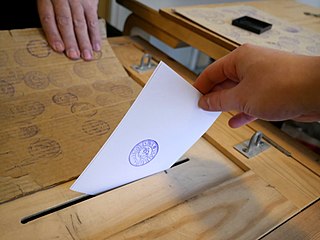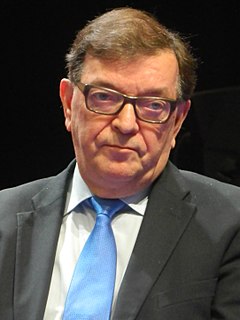The politics of Finland take place within the framework of a parliamentary representative democracy. Finland is a republic whose head of state is President Sauli Niinistö, who leads the nation's foreign policy and is the supreme commander of the Finnish Defence Forces. Finland's head of government is the Prime Minister, who leads the nation's executive branch, called the Finnish Government. Legislative power is vested in the Parliament of Finland, and the Government has limited rights to amend or extend legislation. Because the Constitution of Finland vests power to both the President and Government, the President has veto power over parliamentary decisions, although this power can be overruled by a majority vote in the Parliament.

Taisto Kalevi Sorsa was a Finnish politician who served as Prime Minister of Finland three times: 1972–1975, 1977–1979 and 1982–1987. At the time of his death he still held the record for most days of incumbency as prime minister. He was also a long-time leader of the Social Democratic Party of Finland.

There are four types of elections in Finland. Each Finnish citizen at least 18 years of age has the right to vote in each of the elections, which decide the following: the president, the parliament, the MEPs, and the municipal and city councils.

Finnish People's Democratic League was a Finnish political organisation with the aim of uniting those left of the Finnish Social Democratic Party. It was founded in 1944 as the anti-communist laws in Finland were repealed due to the demands of the Soviet Union, and lasted until 1990, when it merged into the newly formed Left Alliance. At its time, SKDL was one of the largest leftist parties in capitalist Europe, with its main member party, the Communist Party of Finland, being one of the largest communist parties west of the Iron Curtain. The SKDL enjoyed its greatest electoral success in the 1958 parliamentary election, when it gained a support of approximately 23 per cent and a representation of 50 MPs of 200 total, making it the largest party in the Eduskunta.

Paavo Matti Väyrynen is a Finnish veteran politician and a member of the Finnish Parliament, representing the Seven Star Movement and formerly the Citizen's Party and Centre Party. Väyrynen has been a member of the Finnish Parliament previously from 1970 to 1995 and again from 2007 to 2011 and has held many ministerial portfolios. He has also been a Member of the European Parliament from 1995 to 2007, and again from 2014 to 2018.

Parliamentary elections were held in Finland on 16 March 2003. The Centre Party led by Anneli Jäätteenmäki overtook the Social Democratic Party (SDP) to become the largest party in the Eduskunta. This was credited mainly to Jäätteenmäki's powerful leadership and modernization of the party still often viewed as agrarian and conservative by many. However, the SDP actually won some seats and increased its share of the vote, losing in the number of total popular votes only by a few thousand.
Finland Proper is a Finnish constituency. It covers the administrative region of Southwest Finland, with a population of 450,968. Finland Proper elects 17 members to eduskunta.
Central Finland is a Finnish constituency represented in Eduskunta. It covers the administrative region of Central Finland, with a population of about 265,000. Central Finland currently elects ten members of Eduskunta.
North Karelia was an electoral district represented in the Finnish Eduskunta (parliament). In 2013 it was merged with Northern Savonia electoral district to form the Savonia-Karelia electoral district. It covered the administrative region of North Karelia, with a population of 169,722. North Karelia elected six members of the Eduskunta, when in 2005 there were still seven seats.
Pirkanmaa is a Finnish constituency represented in eduskunta. It covers the administrative region of Pirkanmaa, with a population of 453,978. Pirkanmaa currently elects 18 members of the Eduskunta.
Southern Savonia was an electoral district represented in the Finnish Eduskunta (parliament). It covered the administrative region of Southern Savonia, with a population of 163,276. Southern Savonia elected six members of the Eduskunta. The electoral district was merged with Kymi to form the new Southeastern Finland district.
Vaasa is a Finnish constituency represented in eduskunta. It covers the administrative regions of Ostrobothnia, Central Ostrobothnia and Southern Ostrobothnia. Vaasa currently elects 17 members to eduskunta.
Parliamentary elections were held in Finland on 15 and 16 March 1987.

Parliamentary elections were held in Finland on 17 March 1991, the first time a Finnish parliamentary election had been held on a single day.
The European Parliament election of 2009 in Finland was the election of the delegation from Finland to the European Parliament in 2009.

Eino Oskari Uusitalo was a Finnish politician from the Centre Party. He was born in Soini.

Presidential elections were held in Finland in 1988. They were the first elections held under a new system. Previously, the public had elected an electoral college that in turn elected the President. For this election, the public directly elected the President on 31 January and 1 February, but also elected an electoral college that would elect the President if no candidate won over 50% of the popular vote. The college was increased in size from 300 to 301 seats to make a tie less likely, though this was still technically possible, as electors could abstain from voting.













